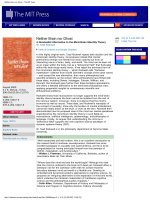The cosmopolitan press, 1760-1815
Bạn đang xem bản rút gọn của tài liệu. Xem và tải ngay bản đầy đủ của tài liệu tại đây (133.83 KB, 25 trang )
1 The cosmopolitan press, –
Simon Burrows
The celebrated cosmopolitanism of Enlightenment Europe was bound
together by a common elite culture, a common elite language (French)
and a common news
media. In consequence, it is surely not unreason-
able to envisage a European public, and even a pan-European public
sphere, albeit a narro
w and largely aristocratic one, which transcended
national publics. For from the Huguenot diaspora to the Napoleonic
period, there existed beyond
French borders a French-language press
that aimed to provide a steady flow of news information and, increas-
ingly, opinion, to an international elite. This press – comprising
political
newspapers produced beyond France’s direct sphere of influence for a
European audience – is the subject of this chapter. Although these papers
were written in French, and at times circulated widely inside France, the
chapter’s focus will be on Europe generally, both because the role of
international papers inside ancien regime France is discussed below in
JackCenser’s chapter, and because they had difficulty circulating there
after . Journals aimed primarily at local francophones in Belgium,
Switzerland, Germany, Poland and other countries are not considered
here, nor are the specialised journals that proliferated in eighteenth-
century Europe. While most international papers were what Jerzy Lojek
has termed ‘international gazettes’,
a few periodicals – such as the Journal
encyclop´edique or Jean-Gabriel Peltier’s ´emigr´e publications – which con-
tained substantial news sections are also worthy of mention. However,
they could not compete with the gazettes for freshness, and risked ac-
cusations of providing ‘news which is not news’.
This survey is also
limited by the secondary literature, for despite extensive recent workon
the international French press in the Enlightenment,
our knowledge and
bibliographic sources are still patchy,
and the situation with regard to
´emigr´e papers is worse.
Despite the international focus of the cosmopolitan press, there is no
escaping the fact that the French Revolution was the most decisive event
in its history. Before , French readers found their freshest, most inde-
pendent news of France in gazettes produced outside the Bourbon realm.
Simon Burrows
Table Leading extra-territorial gazettes during the late ancien regime
Common title Place of Publication Dates Rank
Courier de l’Escaut Malines (?) (Austrian Netherlands) –? /
Courrier d’Avignon Avignon (Papal territory) – / ∗
Courier de l’Europe London, with Boulogne reprint – /
Courier du Bas-Rhin Cleves, Wesel (Prussia) –? /
Gazette d’Altona Altona (Denmark) ?–+
/
Gazette d’Amsterdam Amsterdam (United Provinces) ?–? /
Gazette d’Utrecht Utrecht (United Provinces) ?– /
Gazette de Berne Berne (Switzerland) – / ∗
Gazette de Cologne Cologne (Archbishopric of ) – /
Gazette de La Haye The Hague (United Provinces) –? /
Gazette de Leyde Leiden (United Provinces) – /
Gazette des Deux-Ponts Mannheim (duchy of Deux-Ponts) – /
Gazette de Bruxelles Brussels (Austrian Netherlands) – /
After the collapse of royal control over the printed word in July ,
foreign gazettes no longer offered either advantage. In Paris new jour-
nals whose coverage focused heavily, often exclusively, on events inside
France, now Europe’s hottest news story, proliferated as France’s boldest
political publicists returned from exile, while foreign gazettes lagged days
behind. But although the market for foreign gazettes inside France rapidly
dried up, a lively French-language press survived outside the country
until the end of the Napoleonic era, staffed largely by ´emigr´es.
Before the revolution, the international francophone press was large
and increasingly influential, but it remained significant thereafter. Be-
tween and about sixty French-language political papers were
produced outside France for an international audience, although many
were short-lived.
The most significant are listed in table . All these
papers were classic international gazettes, most of which appeared twice-
weekly, and provided readers with news bulletins and official texts (such
as relations, laws, ordinances, peace treaties and remonstrances), usually
without comment, in a set order, under the putative place and dateline
of the report’s origin. Often several reports would cover the same story,
giving different versions. Readers themselves were expected to make sense
of these discordant reports. This gazette form prospered for over
years, largely due to its commercial orientation: gazettes existed primarily
to sell news information, not to peddle ideology, in marked contrast to
the papers of the revolutionary era. Editorial comment was therefore very
limited – far less significant in terms of space and emphasis than news
bulletins and official texts.
The cosmopolitan press
Table Leading ´emigr´e political papers in Europe, –
Title Emigr´e editors Place Dates
Abeille du nord Barons d’Angely Altona –
L’Ambigu Peltier London –
Annales politiques du Paoli de Chagny Hamburg –
XIXe si`ecle Ratisbon
Censeur Bertin d’Antilly and Mesmont Hamburg –
Correspondance politique Peltier London –
Courier d’Angleterre Regnier London –
Courier de Londres = Verduisant, abb´e Calonne, London –
Courier de l’Europe Montlosier, Regnier, G´erard
Mercure britannique Mallet Du Pan London –
Mercure de France Anonymous committee of six London –
Mercure universel Paoli de Chagny Ratisbon ?–
Paris pendant l’ann´ee Peltier London –
Le Pour et le contre Paoli de Chagny and Sabatier Hamburg
de Castres
Reveil Mesmont Hamburg –
Spectateur du Nord Baudus and Villers Hamburg –
Nevertheless, within these parameters, different gazettes developed dif-
ferences in tone and approach, especially as the Revolution approached,
and from the late s three leading papers, the Courier du Bas-Rhin,
Gazette de Leyde and Courier de l’Europe (founded ), began increas-
ing editorial comment.
When French subscriptions to international
gazettes dropped sharply after , reputation, political engagement –
and in the case of the Courier de l’Europe ideological prostitution – helped
these three papers to survive. For by –, faced with the demands
of partisan politics, it was becoming difficult for international gazettes
to retain their detachment and appeal.
Hence, most disappeared in the
s and several others came under the influence of the ´emigr´es, includ-
ing the Gazette de Cologne, Courier du Bas-Rhin and Courier de l’Europe.
However, the s also witnessed the establishment of numerous pa-
pers by the ´emigr´es themselves. London alone had eleven ´emigr´e papers
between to , including the Courier de l’Europe, which under the
title Courier de Londres survived until , adapting its politics to polit-
ical contingency.
A brief survey of titles produced elsewhere identified
thirty-three more papers edited by ´emigr´es on mainland Europe and in
the United States.
The most important European ´emigr´e papers are
listed in table .
From to the Revolution, France was the most important market
for the cosmopolitan press. Although ancien regime French readers had
Simon Burrows
been introduced to an illegal literature of ideas by a flourishing clan-
destine pamphlet trade, they found fresh, miscellaneous political news –
especially of France – hard to come by until the s. The handful of
foreign gazettes that were permitted to circulate in the post – notably
the Courrier d’Avignon, Gazette d’Amsterdam and Gazette d’Utrecht – were
prohibitively expensive, and the only domestic newspaper, the Gazette
de France, was insipid, heavily censored, court-centred and offered little
French political news.
However, after the so-called ‘postal revolution’
of , the government tolerated the importation under licence of var-
ious foreign gazettes and granted a monopoly over their distribution at
a moderate fixed price via the postal service. The postal revolution cut
prices by around per cent and thereafter sales of international gazettes
rose rapidly: , subscribers in had become , by . This
compares with a circulation of almost , for domestically produced
newspapers.
After the postal revolution France became the most im-
portant market for international gazettes. As a result
they proliferated
and the French government gained increased powers of suasion over
them.
Total sales of international gazettes and individual titles were closely
connected to political events. They boomed in the Seven
Years War,
fell backafter the peace, peaked again during the American Revolution,
and then began to climb again in the pre-revolutionary crisis.
After the
French Revolution subscriptions inside France to all categories of foreign
news periodical fell to negligible levels. However, there was also a signifi-
cant market beyond France. In November , the Courier de l’Europe’s
London print-run was ,
a level that was probably relatively constant
until further boosted by the pre-Revolution and coming of the ´emigr´es.
Until the Revolution a much larger edition for the continent was printed at
Boulogne. The Gazette de Leyde’s circulation peaked during the American
Revolution at , subscribers, of whom only , lived in France or
Brabant, plus perhaps , more for counterfeit editions.
The Courier
du Bas-Rhin, although banned in revolutionary France, had a circulation
of in and in .
Among ´emigr´e journals, Peltier’s
Correspondance politique boasted at least subscribers in Britain and
in continental Europe and Mallet Du Pan’s twice-monthly Mercure
britannique probably had , to , subscribers plus perhaps ,
more for its various counterfeit editions. Regnier’s Courier d’Angleterre dis-
tributed an average of copies per issue in .
Surviving evidence
allows us to speculate that before the Revolution international gazettes
had a total of perhaps –, subscribers outside France, roughly
matching their circulation inside. This total excludes the phenomenally
successful Annales politiques, civiles et litt´eraires du dix-huiti`eme si`ecle of
The cosmopolitan press
Simon-Nicolas-Henri Linguet, more a commentary on political events
than a newspaper, which sold over , copies Europe-wide. After the
Revolution, despite enormous upheavals in the market and the collapse
of many international gazettes, French extra-territorial papers continued
to have several thousand subscribers outside France. These numbers,
though small, were not insignificant, especially given multiple readers
and the social status of the readership.
Although detailed subscription lists do not survive, there is no doubt
that the extra-territorial French press served an elite audience. Jeremy
Popkin’s analysis of the content of the Gazette de Leyde convincingly
demonstrates that it performed the main function of an ‘elite press’, deliv-
ering the highest possible quality political news to a wealthy cosmopoli-
tan audience. Like the other French international gazettes and ´emigr´e
papers, it was almost wholly reliant on subscription
revenue.
However,
what little advertising it carried targeted the wealthiest stra
ta of ancien
regime society, the potential purchasers of large estates and luxury goods
across Europe and beyond. For according to the abb´e Bianchi ‘the Dutch
gazettes are read at Constantinople, Smyrna, Cairo, in the Levant, in both
Indies, just as at the Hague and in the caf´es of Amsterdam’.
German
papers were also widely available. The Gazette des Deux-Ponts’s distri-
bution spanned London, Versailles, the Rhineland, Berlin, Rome and
Vienna while in the newly founded Courier du Bas-Rhin was circu-
lating widely in France, Germany, Austria, Bohemia, the Low Countries,
Switzerland and Italy.
As Popkin notes, the international gazettes were
required reading for diplomats and politicians,
but they were also avail-
able to readers from other social strata. Paul Benhamou found French
readers could pay to read international gazettes in the premises of Parisian
gazetiers, and in numerous cabinets de lecture( public reading rooms),soci´et´es
d’amateurs (associations of literature enthusiasts who subscribed for jour-
nals collectively) and chambres de lecture (clubs of individuals who gath-
ered to read and discuss papers purchased in common) across France.
There were also a large number of sociable sites where gazettes, though
not the primary attraction, were usually available gratis, including caf´es,
clubs, gambling dens and smoking rooms.
International gazettes might
be encountered in the remotest corners of Europe and the Mediterranean.
By the late s, a French soldier in the Russian army in Moldavia could
buy fresh editions of the Gazette de Leyde from Jewish merchants, and the
comte de La Motte could read the paper in a Glasgow caf´e.
A decade
later, while campaigning in Egypt, Napoleon updated himself on French
affairs from copies of the Courier de Londres acquired from the British
navy,
while French police reports reveal that in Peltier’s L’Ambigu
was circulating at Tunis ‘in the caf´es, auberges and other public places’.
Simon Burrows
These examples suggest that international gazettes were reaching social
groups well beyond politicians, diplomats and courtly and aristocratic
elites and that a variety of titles were available to the public at a modest
price in moderate-sized towns across Europe and even beyond.
After the Revolution, ´emigr´e papers continued to serve an elite au-
dience. Mallet Du Pan’s Mercure britannique’s readers included British
princes and ministers, various European diplomats, Tsar Paul I, the Duke
of Brunswick, the Prince of Brazil and ‘many other persons of rank
and of parliamentary and literary distinction’.
The Courier d’Angleterre
circulated among some of the Tsar’s leading Francophobe advisors,
Swedish aristocrats and the leading counter-revolutionary publicists.
But ´emigr´e journals also served other audiences, notably French exiles
and French-speaking merchants.
The most successful international gazettes were based along major
trade routes, mostly in smaller
states with considerable autonomy and
liberal censorship regimes. The oldest were established in the United
Provinces by Huguenot refugees in the late seventeenth century.
Others were published in the German Rhineland, the German free city
of Hamburg, the neighbouring Danish free city of Altona and a handful
of small states along the French frontier. These included the principal-
ity of Bouillon; the Prussian enclave of Cleves (home to the Courier du
Bas-Rhin); the Duchy of Deux-Ponts and the papal enclave of Avignon.
London emerged as a publishing centre belatedly, and only for political
reasons. Cut off from the sources of Continental news, it only became a
viable base in the s and early s, when Britain’s struggle to re-
tain its American colonies became Europe’s leading story. The Courier
de l’Europe was launched to take advantage of these circumstances, but
its proprietors soon felt the need for a Continental edition at Boulogne.
After the peace, subscriptions fell sharply. Moreover, until the French
Revolution, London’s French journalists were widely acknowledged to be
the lowest class of muck-rakers. The Courier de l’Europe’s founding editor,
Alphonse-Joseph de Serres de La Tour, was a romantic refugee from
roya
l justice, who had absconded to London with the aristocratic wife
of his well-connected employer. His successors Charles Th´eveneau de
Morande and Joseph Perkins MacMahon were blackmailers and libellistes.
Morande was also a French spy. London only became the premier French
extra-territorial news centre once more in the mid-s, as revolution-
ary armies advanced, quashing Dutch and German press liberty. In-
creasingly, only London seemed to offer both a reasonably free press
beyond the reach of French influence and a significant French commu-
nity. By Mallet Du Pan could write to a friend: ‘As for the public ...
one must leave the continent in order to speakto it; for there is no longer
The cosmopolitan press
anywhere where anyone can print a line against the Directory and its
manoeuvres ...Only in England can one write, think, speak or act.’
Before the Revolution, France had few career journalists. According to
William Murray, Mallet Du Pan and Linguet were probably the first.
However, both began their journalistic careers beyond French borders,
and there the situation is not so clear. In London several pre-revolutionary
exiles worked on more than one paper, including Serres de La Tour,
Perkins MacMahon and Morande. Jean Manzon, the Piedmontese editor
of the Courier du Bas-Rhin, and his arch-rival Jean Luzac, who edited the
Gazette de Leyde from to , should also be considered career jour-
nalists. So perhaps should Jacques-Pierre Brissot, who was the indexer
of Linguet’s Annales and an administrator and later journalist with the
Courier de l’Europe before establishing a succession of papers. The revo-
lutionary journalistic partners Pascal Boyer and Antoine-Marie Cerisier
also began their careers with the extra-territorial press before .
Among numerous motives that drew these men to journalism, money
was certainly important. The profits for a successful journalist-proprietor
were considerable. According to Brissot, Serres de La Tour often boasted
that he earned more money in a year from his one-third share in the
Courier de l’Europe’s profits than Jean-Jacques Rousseau had made in a
lifetime as a philosophe.
Likewise, Jean Luzac’s revenues from the Gazette
de Leyde exceeded those of the entire University of Leiden, where he was
also a professor.
Even ´emigr´e journalists earned considerable sums.
Mallet Du Pan’s income as editor-proprietor of the Mercure britannique
exceeded the lavish salary of , livres he had earned in the s
as political editor of Panckoucke’s Mercure de France, despite a much
smaller circulation. His rival Peltier lived extravagantly, and journalism
helped him to recover from a series of bankruptcies.
Journalism also offered exiles an opportunity to remain politically
involved. For many it was a conscious choice for this reason and
even before the most successful journalists were characterised by
their ideological commitment. Both Jean Luzac and Manzon promoted
moderate variants of Enlightenment: Luzac championing representative
bodies, Manzon supporting enlightened absolutism, penal reform and
d’Holbachian materialism.
Linguet used his journal primarily as a
‘tribune’ to advance his views rather than record news,
and his example
was followed from by Morande, who, finding an independent jour-
nalistic voice, espoused the cause of patriotic reform in his editorials and
Lettres d’un voyageur. Morande’s articles were highly engaged, topical
and prescriptive. They broke new ground in French newspaper journal-
ism and attempted to lead public debate. Nothing like them appeared in
other French-language newspapers during the pre-Revolution.
Their
Simon Burrows
style was imitated by journalists in revolutionary Paris, where it created
a ‘new type of demagogue’, the tribune of the people, who transformed
Linguet’s activism into calls for direct action.
Commitment to a cause
became a hallmarkof ´emigr´e journalism too, as Mallet Du Pan made ex-
plicit when he declared the Mercure britannique’s aim ‘of reviving in every
quarter the courage of governments and nations overwhelmed or men-
aced by the French Republic; of showing them the necessity of resistance,
and inspiring the hope of
success, if supported by united endeavours and
the rectitude of intention’.
Given their audience and the sensitive information and heterodox ideas
they sometimes carried, it is hardly surprising that ancien regime govern-
ments sought to contain or control the content of international papers.
Their most obvious expedient was to ban gazettes from
circulating on
their own territories. Joseph II punished the Gazette de Leyde by giving
a third party exclusive rights to reprint and disseminate the journal in
the Habsburg realms, allowing news to circulate but hitting the news-
paper’s owner
s in the pocket.
Until the French also permitted
cheap reprints, but found that this left editors no financial incentive
to adopt a moderate tone: perhaps this is why they eventually decided
to admit cheap foreign gazettes.
They also found that temporary in-
terdictions were more flexible. They briefly banned the Courier du Bas
Rhin in for publishing extracts of an anti-religious tract; the Gazette
d’Utrecht in in order to intimidate other papers; and the Courier de
l’Europe in for publishing a letter mistreating Marie-Antoinette and
Maurepas.
However, bans could not prevent the circulation of unfavourable news
information on foreign soil and among the policy-makers and diplomatic
corps of rival powers. Ancien regime governments therefore often re-
sorted to diplomatic complaints to silence recalcitrant journalists, with
varying success.
From the late seventeenth century onwards there was
a steady stream of diplomatic complaints against Dutch international
gazettes.
The authorities in the Netherlands often tookpositive ac-
tion in response to complaints. One from the Prussian government in
led to a temporary interdiction on the Gazette de La Haye, which
resulted in its permanent closure.
But such brutal effectiveness was
rare and the influence that the Prussians enjoyed in Holland after their
intervention in the patriot revolution in was exceptional. Usually
diplomatic complaints had lesser effects. Jean Veycrusse has traced thirty
complaints against Dutch gazettes in French archives dating from the
period –, most originating from the highest levels of French
society rather than government. Of these thirty cases, the French gov-
ernment tookaction over twenty-eight, pressurising the journalists to
The cosmopolitan press
backdown and print retractions or corrections in at least twenty-four.
Complaints elsewhere forced similar retractions: in the Gazette de
Berne was forced to print a humiliating retraction of a ‘false and calum-
nious’ notice which had wrongly attributed a scandalous banned work
to Voltaire, after the philosophe complained to the Bernese authorities.
Sometimes complaints resulted in sanctions. In , Etienne Luzac was
reprimanded for offending the Grand Master of the Order of Malta and
ordered not to print commentaries in future.
Despite the high success rate of such complaints, warnings, bans and
admonitions seldom had much lasting effect. In the Netherlands, at least,
this was in part due to the devolved po
wer structure, and the same was
possibly true, to a certain extent, in the Holy Roman Empire. Moreover, if
pushed too hard, editors might imitate Gueudeville who, finding his Esprit
des
cours de l
’Europe suppressed
in
,
merely changed its title.
Or
they might move their operation, like Pierre Rousseau, whose peripatetic
Journal encyclop´edique moved from Li`ege to Brussels before finally finding
a safe home in Bouillon.
Moreover, bans and complaints could prove
counter-productive. Jean-Baptiste de la Varenne, editor of the Glaneur
historique, welcomed them, believing that they promoted sales, while in
the M´emoires secr`etes predicted that the Courier de l’Europe’s notoriety
would win it many subscribers once the French government lifted its
interdiction.
Dutch editors could sometimes afford to be defiant. In
response to French complaints in Etienne Luzac replied that if he
limited himself to French news published in the Gazette de France, ‘it
would alert the French public that we were holding backand produce the
opposite of the desired effect’.
In the same year he refused to bow to
Danish complaints that he had refused to endorse charges brought against
the reforming minister Struensee, who was executed after a palace coup.
However, Luzac’s bold declaration that he would ‘never depart from the
truth either out of enmity or from a desire to please men in high places’
was largely bluster. Already in , following French complaints, he
had ceased publishing material on the Maupeou crisis in France.
The
Gazette d’Amsterdam, Gazette de La Haye and Gazette d’Utrecht bowed
before similar pressure.
Nevertheless, Etienne Luzac’s comments showed that governments
were caught in a cleft stick. If they wanted to persuade a broad European
public of their version of events, they had to use news channels that
enjoyed that public’s confidence and maintained their appearance of in-
dependence by publishing documents from all parties. In turn, this meant
that governments were forced to attempt to persuade. In the process they
admitted tacitly that they recognised the legitimacy of the judgements of a
‘public’, however limited, and existence of alternative sources of authority
Simon Burrows
and hence, that monarchs were not the only political actors within their
states.
Realising that they could not always suppress hostile news coverage,
governments sought more effective means to moderate and guide cover-
age of affairs in the international press. One way to achieve this was to
attempt to bribe editors and proprietors. Thus, Manzon – who readily
sold his pen on issues which affected neither Prussian interests nor his
own personal crusades – was paid to push a pro-Polish line by the Polish
King, Stanislaus-Augustus Poniatowski, until –, when Russian pres-
sure forced the journalist to change tack.
In the s, it was rumoured
that the French had bribed the only Dutch gazettes permitted to enter
France. It was said that Du Breuil, the editor of the Gazette d’Amsterdam,
was paid , livres for allowing the French ambassador to vet his paper,
while Madame de Limiers was said to have received –, livres for
pro-French coverage in the Gazette d’Utrecht.
The French postal rev-
olution of was also a form of bribe, for by opening the frontiers to
other selected gazettes and slashing the cost of postage, the French were
opening up the largest market in Europe. No editor
could afford to ignore
this incentive, although one complained that the circumspection required
to gain admission had made his gazette too ‘dull’ for readers outside
France.
Moreover, according to manuscript newsletters the French gov-
ernment ‘bought’ the Courier de l’Europe during the American Revolution
with a mass-subscription, allegedly for , copies, an improbably high
amount.
But if it was to remain a credible organ they had to allow it
considerable leeway for, as its proprietor remarked, it would lose all in-
terest if it was sensed to be written from Paris.
This paradox dogged the
French in their attempts to moderate the foreign gazettes. It would also
prove problematic to British attempts to use the ´emigr´e press after .
Governments also began to develop techniques of news management.
Several German powers established international gazettes as a means to
exercise direct control over a paper while promoting their interests with
an international public. The Gazette de Cologne, founded in , fought
assiduously for causes supported by its prince-bishop electors. It op-
posed the philosophes and religious laxity and became a mouthpiece for the
Jesuits after their expulsion from France.
The liberal Duke Christian IV
of Deux-Ponts, who had close ties with the philosophes, established a liter-
ary journal to be their organ and contemporaries saw a similar influence
behind the Gazette des Deux-Ponts, which was edited under bureaucratic
supervision.
So was the Courier du Bas-Rhin, which served notoriously
as a Prussian ‘propaganda bridgehead’ into Western Europe.
How-
ever, although his paper regularly published Prussian-inspired disinfor-
mation and commentaries on international affairs and was no freer in









